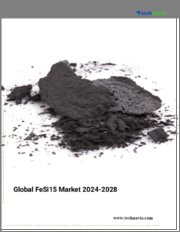
|
시장보고서
상품코드
1575216
합금철 시장 규모, 점유율, 동향 분석 보고서 : 제품별, 용도별, 지역별, 부문별 예측(2024-2030년)Ferroalloys Market Size, Share & Trends Analysis Report By Product (Ferrochrome, Ferromanganese), By Application (Carbon & Low Alloy Steel, Stainless Steel), By Region, And Segment Forecasts, 2024 - 2030 |
||||||
합금철 시장 성장과 동향:
Grand View Research, Inc.의 최신 보고서에 따르면 세계 합금철 시장 규모는 2024년부터 2030년까지 연평균 8.4% 성장하여 2030년까지 867억 2,000만 달러에 달할 것으로 예상됩니다.
주요 산업의 철강 소비 증가는 합금철에 대한 안정적인 수요로 이어지고 있습니다. 또한, 대중에게 저렴한 주택을 제공하기 위한 정부의 노력, 세계 메가시티의 수 증가 및 진행 중인 산업화 활동은 철강에 대한 세계 수요에 기여할 것으로 예상됩니다. 이는 향후 몇 년 동안 합금철 시장의 성장을 촉진할 것으로 예상됩니다.
전기자동차(EV) 및 항공우주 산업에서 페로실리콘망간 사용 증가는 예측 기간 동안 합금철에 대한 세계 수요를 유지할 것으로 예상됩니다. 청정에너지로의 산업 전환이 진행되고 친환경 철강에 대한 관심이 높아지면서 탄소발자국이 적은 새로운 강종을 생산하기 위한 연구 개발 활동이 진행되고 있습니다. 또한, 주철에 대한 세계 수요는 예측 기간 동안 높은 수준을 유지할 것으로 예상되며, 향후 몇 년 동안 합금철 시장의 수익을 유지할 것으로 예상됩니다. 주철은 전통적인 내연기관(ICE)에 광범위하게 사용되는 것 외에도 현대의 전통적인 조리기구를 대체할 수 있는 저비용의 건강한 주철 조리기구에도 사용되고 있습니다.
세계 각국 정부의 노력은 세계 철강 소비를 증가시킬 것으로 예상됩니다. 예를 들어, 미국의 초당적 인프라법 및 인플레이션 감소법, 인도의 국가 투자 및 인프라 기금, G7에 기반한 세계 인프라 및 투자 파트너십은 철강 소비를 촉진하고 예측 기간 동안 합금철 시장에 활력을 불어넣을 것으로 예상됩니다.
합금철 시장 보고서 하이라이트
- 제품별로는 페로실리콘망간 부문이 2023년 시장에서 45.0% 이상의 가장 큰 매출 점유율을 차지했습니다. 페로실리콘 망간은 철강, 스테인리스 강, 망간이 풍부한 철강 생산시 합금화 제 및 탈산제로 사용되며 EV 및 항공우주 산업에서 널리 사용됩니다.
- 용도별로는 주철 부문이 예측 기간 동안 가장 높은 매출 CAGR 7.0%로 성장할 것으로 예상됩니다. 이 부문의 성장은 주철이 조리기구 제조에 사용되기 때문인 것으로 분석됩니다.
- 지역별로 보면 아시아태평양은 조강 생산량이 많기 때문에 2023년 합금철 수요가 가장 높았습니다.
- 2023년 5월, Indian Metals and Ferro Alloys Limited(IMFA)는 인도 오디샤주 칼링가나가에 6,520만 달러(54억 7,000만 인도 루피) 규모의 페로크롬 확장 프로젝트를 발표했습니다.
목차
제1장 조사 방법과 범위
제2장 주요 요약
제3장 시장 변수, 동향, 범위
- 세계의 합금철 시장 전망
- 밸류체인 분석
- 원자재 동향
- 제조와 기술 개요
- 규제 프레임워크
- 시장 역학
- 시장 성장 촉진요인 분석
- 시장 성장 억제요인 분석
- 시장 기회
- 업계 동향
- Porter's Five Forces 분석
- 공급 기업의 교섭력
- 구매자의 교섭력
- 대체의 위협
- 신규 참여업체의 위협
- 경쟁 기업 간의 경쟁 관계
- PESTLE 분석
- 정치
- 경제
- 사회 상황
- 기술
- 환경
- 법률
제4장 합금철 시장 : 제품 추정·동향 분석
- 합금철 시장 : 제품 변동 분석, 2023년·2030년
- 페로크롬
- 페로망간
- 페로실리코망간
- 페로실리콘
제5장 합금철 시장 : 용도 추정·동향 분석
- 합금철 시장 : 용도 변동 분석, 2023년·2030년
- 탄소강·저합금강
- 스테인리스강
- 합금강
- 주철
- 기타
제6장 합금철 시장 : 지역 추정·동향 분석
- 지역 분석, 2023년·2030년
- 북미
- 제품별, 2018-2030년
- 용도별, 2018-2030년
- 미국
- 캐나다
- 멕시코
- 유럽
- 제품별, 2018-2030년
- 용도별, 2018-2030년
- 독일
- 영국
- 프랑스
- 이탈리아
- 터키
- 러시아
- 아시아태평양
- 제품별, 2018-2030년
- 용도별, 2018-2030년
- 중국
- 인도
- 일본
- 중남미
- 제품별, 2018-2030년
- 용도별, 2018-2030년
- 브라질
- 중동 및 아프리카
- 제품별, 2018-2030년
- 용도별, 2018-2030년
제7장 경쟁 상황
- 최근의 동향과 영향 분석 : 주요 시장 진출 기업별
- Kraljic Matrix
- 기업 분류
- 히트맵 분석
- 벤더 상황
- 원자재 공급업체 리스트
- 판매대리점 리스트
- 기타 주요 제조업체 리스트
- 잠재적 최종사용자 리스트
- 전략 매핑
- 기업 개요/상장 기업
- Gulf Ferro Alloys Company(Sabayek)
- Glencore
- Jindal Group
- S.C. Feral S.R.L
- SAIL
- Samancore Chrome
- Shanghai Shenjia Ferroalloys Co. Ltd
- Tata Steel Limited
Ferroalloys Market Growth & Trends:
The global ferroalloys market size is anticipated to reach USD 86.72 billion by 2030, growing at a CAGR of 8.4% from 2024 to 2030, according to a new report by Grand View Research, Inc. The growing consumption of steel across key industries has led to steady ferroalloy requirements. Moreover, the government initiatives to provide affordable housing to the masses, the rising number of megacities worldwide, and ongoing industrialization activities are anticipated to contribute to the global demand for steel. This is expected to subsequently drive the growth of the ferroalloys market in the coming years.
Increasing use of ferro silico manganese in the electric vehicle (EV) and aerospace industries is anticipated to sustain the global demand for ferroalloys over the forecast period. The ongoing transition of industries to clean energy and the growing interest in green steel have led to research and development activities to produce new grades of steel that have a low carbon footprint. Moreover, the global demand for cast iron is anticipated to remain high during the forecast period and sustain revenues for the ferroalloys market in the coming years. Apart from its extensive usage in conventional internal combustion engines (ICEs), it is also used in cast iron cookware, a low-cost and healthy alternative to modern traditional cookware.
Initiatives by governments of different countries across the world are anticipated to boost global steel consumption. For instance, the Bipartisan Infrastructure Law and Inflation Reduction Act in the U.S., the National Investment and Infrastructure Fund in India, and the G7-based Partnership for Global Infrastructure and Investment are expected to drive the steel consumption and provide impetus to the ferroalloy market over the forecast period.
Ferroalloys Market Report Highlights:
- Based on product, the ferro silico manganese segment accounted for the largest revenue share of over 45.0% of the market in 2023. Ferro silico manganese is used as an alloying and deoxidizing agent during the production of steel, stainless steel, and manganese-rich steel. It is extensively used in the EV and aerospace industries.
- Based on application, the cast iron segment of the market is projected to grow at the highest revenue CAGR of 7.0% over the forecast period. The segment's growth can be attributed to the use of cast iron for producing cookware.
- Based on region, the Asia Pacific region witnessed the highest demand for ferroalloys in 2023 owing to the large production volume of crude steel in the region.
- In May 2023, Indian Metals and Ferro Alloys Limited (IMFA) announced its USD 65.2 million (INR 547 crore) ferrochrome expansion project in Kalinganagar, Odisha, India with 100,000 MTPA installed capacity is expected to be commissioned in mid-2026.
Table of Contents
Chapter 1. Methodology and Scope
- 1.1. Market Segmentation & Scope
- 1.2. Market Definition
- 1.3. Information Procurement
- 1.3.1. Information Analysis
- 1.3.2. Market Formulation & Data Visualization
- 1.3.3. Data Validation & Publishing
- 1.4. Research Scope and Assumptions
- 1.4.1. List of Data Sources
Chapter 2. Executive Summary
- 2.1. Market Snapshot
- 2.2. Segmental Outlook
- 2.3. Competitive Outlook
Chapter 3. Market Variables, Trends, and Scope
- 3.1. Global Ferroalloys Market Outlook
- 3.2. Value Chain Analysis
- 3.2.1. Raw Material Trends
- 3.3. Manufacturing & Technology Overview
- 3.4. Regulatory Framework
- 3.5. Market Dynamics
- 3.5.1. Market Driver Analysis
- 3.5.2. Market Restraint Analysis
- 3.5.3. Market Opportunities
- 3.5.4. Industry Trends
- 3.5.4.1. ESG Analysis
- 3.5.4.2. Trade Trends
- 3.6. Porter's Five Forces Analysis
- 3.6.1. Bargaining Power of Suppliers
- 3.6.2. Bargaining Power of Buyers
- 3.6.3. Threat of Substitution
- 3.6.4. Threat of New Entrants
- 3.6.5. Competitive Rivalry
- 3.7. PESTLE Analysis
- 3.7.1. Political
- 3.7.2. Economic
- 3.7.3. Social Landscape
- 3.7.4. Technology
- 3.7.5. Environmental
- 3.7.6. Legal
Chapter 4. Ferroalloys Market: Product Estimates & Trend Analysis
- 4.1. Ferroalloys Market: Product Movement Analysis, 2023 & 2030
- 4.2. Ferrochrome
- 4.2.1. Market estimates and forecasts, 2018 - 2030 (Kilo Tons) (USD Million)
- 4.3. Ferromanganese
- 4.3.1. Market estimates and forecasts, 2018 - 2030 (Kilo Tons) (USD Million)
- 4.4. Ferro silico manganese
- 4.4.1. Market estimates and forecasts, 2018 - 2030 (Kilo Tons) (USD Million)
- 4.5. Ferrosilicon
- 4.5.1. Market estimates and forecasts, 2018 - 2030 (Kilo Tons) (USD Million)
Chapter 5. Ferroalloys Market: Application Estimates & Trend Analysis
- 5.1. Ferroalloys Market: Application Movement Analysis, 2023 & 2030
- 5.2. Carbon & Low Alloy Steel
- 5.2.1. Market estimates and forecasts, 2018 - 2030 (Kilo Tons) (USD Million)
- 5.3. Stainless Steel
- 5.3.1. Market estimates and forecasts, 2018 - 2030 (Kilo Tons) (USD Million)
- 5.4. Alloy Steel
- 5.4.1. Market estimates and forecasts, 2018 - 2030 (Kilo Tons) (USD Million)
- 5.5. Cast Iron
- 5.5.1. Market estimates and forecasts, 2018 - 2030 (Kilo Tons) (USD Million)
- 5.6. Others
- 5.6.1. Market estimates and forecasts, 2018 - 2030 (Kilo Tons) (USD Million)
Chapter 6. Ferroalloys Market: Regional Estimates & Trend Analysis
- 6.1. Regional Analysis, 2023 & 2030
- 6.2. North America
- 6.2.1. Market estimates and forecasts, 2018 - 2030 (Kilo Tons) (USD Million)
- 6.2.2. Market estimates and forecasts, by product, 2018 - 2030 (Kilo Tons) (USD Million)
- 6.2.3. Market estimates and forecasts, by application, 2018 - 2030 (Kilo Tons) (USD Million)
- 6.2.4. U.S.
- 6.2.4.1. Market estimates and forecasts, 2018 - 2030 (Kilo Tons) (USD Million)
- 6.2.4.2. Market estimates and forecasts, by product, 2018 - 2030 (Kilo Tons) (USD Million)
- 6.2.4.3. Market estimates and forecasts, by application, 2018 - 2030 (Kilo Tons) (USD Million)
- 6.2.5. Canada
- 6.2.5.1. Market estimates and forecasts, 2018 - 2030 (Kilo Tons) (USD Million)
- 6.2.5.2. Market estimates and forecasts, by product, 2018 - 2030 (Kilo Tons) (USD Million)
- 6.2.5.3. Market estimates and forecasts, by application, 2018 - 2030 (Kilo Tons) (USD Million)
- 6.2.6. Mexico
- 6.2.6.1. Market estimates and forecasts, 2018 - 2030 (Kilo Tons) (USD Million)
- 6.2.6.2. Market estimates and forecasts, by product, 2018 - 2030 (Kilo Tons) (USD Million)
- 6.2.6.3. Market estimates and forecasts, by application, 2018 - 2030 (Kilo Tons) (USD Million)
- 6.3. Europe
- 6.3.1. Market estimates and forecasts, 2018 - 2030 (Kilo Tons) (USD Million)
- 6.3.2. Market estimates and forecasts, by product, 2018 - 2030 (Kilo Tons) (USD Million)
- 6.3.3. Market estimates and forecasts, by application, 2018 - 2030 (Kilo Tons) (USD Million)
- 6.3.4. Germany
- 6.3.4.1. Market estimates and forecasts, 2018 - 2030 (Kilo Tons) (USD Million)
- 6.3.4.2. Market estimates and forecasts, by product, 2018 - 2030 (Kilo Tons) (USD Million)
- 6.3.4.3. Market estimates and forecasts, by application, 2018 - 2030 (Kilo Tons) (USD Million)
- 6.3.5. UK
- 6.3.5.1. Market estimates and forecasts, 2018 - 2030 (Kilo Tons) (USD Million)
- 6.3.5.2. Market estimates and forecasts, by product, 2018 - 2030 (Kilo Tons) (USD Million)
- 6.3.5.3. Market estimates and forecasts, by application, 2018 - 2030 (Kilo Tons) (USD Million)
- 6.3.6. France
- 6.3.6.1. Market estimates and forecasts, 2018 - 2030 (Kilo Tons) (USD Million)
- 6.3.6.2. Market estimates and forecasts, by product, 2018 - 2030 (Kilo Tons) (USD Million)
- 6.3.6.3. Market estimates and forecasts, by application, 2018 - 2030 (Kilo Tons) (USD Million)
- 6.3.7. Italy
- 6.3.7.1. Market estimates and forecasts, 2018 - 2030 (Kilo Tons) (USD Million)
- 6.3.7.2. Market estimates and forecasts, by product, 2018 - 2030 (Kilo Tons) (USD Million)
- 6.3.7.3. Market estimates and forecasts, by application, 2018 - 2030 (Kilo Tons) (USD Million)
- 6.3.8. Turkey
- 6.3.8.1. Market estimates and forecasts, 2018 - 2030 (Kilo Tons) (USD Million)
- 6.3.8.2. Market estimates and forecasts, by product, 2018 - 2030 (Kilo Tons) (USD Million)
- 6.3.8.3. Market estimates and forecasts, by application, 2018 - 2030 (Kilo Tons) (USD Million)
- 6.3.9. Russia
- 6.3.9.1. Market estimates and forecasts, 2018 - 2030 (Kilo Tons) (USD Million)
- 6.3.9.2. Market estimates and forecasts, by product, 2018 - 2030 (Kilo Tons) (USD Million)
- 6.3.9.3. Market estimates and forecasts, by application, 2018 - 2030 (Kilo Tons) (USD Million)
- 6.4. Asia Pacific
- 6.4.1. Market estimates and forecasts, 2018 - 2030 (Kilo Tons) (USD Million)
- 6.4.2. Market estimates and forecasts, by product, 2018 - 2030 (Kilo Tons) (USD Million)
- 6.4.3. Market estimates and forecasts, by application, 2018 - 2030 (Kilo Tons) (USD Million)
- 6.4.4. China
- 6.4.4.1. Market estimates and forecasts, 2018 - 2030 (Kilo Tons) (USD Million)
- 6.4.4.2. Market estimates and forecasts, by product, 2018 - 2030 (Kilo Tons) (USD Million)
- 6.4.4.3. Market estimates and forecasts, by application, 2018 - 2030 (Kilo Tons) (USD Million)
- 6.4.5. India
- 6.4.5.1. Market estimates and forecasts, 2018 - 2030 (Kilo Tons) (USD Million)
- 6.4.5.2. Market estimates and forecasts, by product, 2018 - 2030 (Kilo Tons) (USD Million)
- 6.4.5.3. Market estimates and forecasts, by application, 2018 - 2030 (Kilo Tons) (USD Million)
- 6.4.6. Japan
- 6.4.6.1. Market estimates and forecasts, 2018 - 2030 (Kilo Tons) (USD Million)
- 6.4.6.2. Market estimates and forecasts, by product, 2018 - 2030 (Kilo Tons) (USD Million)
- 6.4.6.3. Market estimates and forecasts, by application, 2018 - 2030 (Kilo Tons) (USD Million)
- 6.5. Central & South America
- 6.5.1. Market estimates and forecasts, 2018 - 2030 (Kilo Tons) (USD Million)
- 6.5.2. Market estimates and forecasts, by product, 2018 - 2030 (Kilo Tons) (USD Million)
- 6.5.3. Market estimates and forecasts, by application, 2018 - 2030 (Kilo Tons) (USD Million)
- 6.5.4. Brazil
- 6.5.4.1. Market estimates and forecasts, 2018 - 2030 (Kilo Tons) (USD Million)
- 6.5.4.2. Market estimates and forecasts, by product, 2018 - 2030 (Kilo Tons) (USD Million)
- 6.5.4.3. Market estimates and forecasts, by application, 2018 - 2030 (Kilo Tons) (USD Million)
- 6.6. Middle East & Africa
- 6.6.1. Market estimates and forecasts, 2018 - 2030 (Kilo Tons) (USD Million)
- 6.6.2. Market estimates and forecasts, by product, 2018 - 2030 (Kilo Tons) (USD Million)
- 6.6.3. Market estimates and forecasts, by application, 2018 - 2030 (Kilo Tons) (USD Million)
Chapter 7. Competitive Landscape
- 7.1. Recent Developments & Impact Analysis, by Key Market Participants
- 7.2. Kraljic Matrix
- 7.3. Company Categorization
- 7.4. Heat Map Analysis
- 7.5. Vendor Landscape
- 7.5.1. List of Raw Material Suppliers
- 7.5.2. List of Distributors
- 7.5.3. List of Other Prominent Manufacturers
- 7.5.4. List of Prospective End-Users
- 7.6. Strategy Mapping
- 7.7. Company Profiles/Listing
- 7.7.1. Gulf Ferro Alloys Company (Sabayek)
- 7.7.1.1. Company Overview
- 7.7.1.2. Financial Performance
- 7.7.1.3. Product Benchmarking
- 7.7.2. Glencore
- 7.7.2.1. Company Overview
- 7.7.2.2. Financial Performance
- 7.7.2.3. Product Benchmarking
- 7.7.3. Jindal Group
- 7.7.3.1. Company Overview
- 7.7.3.2. Product Benchmarking
- 7.7.4. S.C. Feral S.R.L
- 7.7.4.1. Company Overview
- 7.7.4.2. Product Benchmarking
- 7.7.5. SAIL
- 7.7.5.1. Company Overview
- 7.7.5.2. Financial Performance
- 7.7.5.3. Product Benchmarking
- 7.7.6. Samancore Chrome
- 7.7.6.1. Company Overview
- 7.7.6.2. Product Benchmarking
- 7.7.7. Shanghai Shenjia Ferroalloys Co. Ltd
- 7.7.7.1. Company Overview
- 7.7.7.2. Financial Performance
- 7.7.7.3. Product Benchmarking
- 7.7.8. Tata Steel Limited
- 7.7.8.1. Company Overview
- 7.7.8.2. Financial Performance
- 7.7.8.3. Product Benchmarking
- 7.7.1. Gulf Ferro Alloys Company (Sabayek)
(주말 및 공휴일 제외)


















